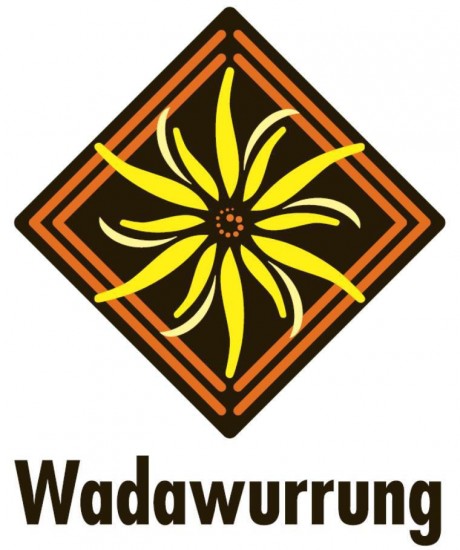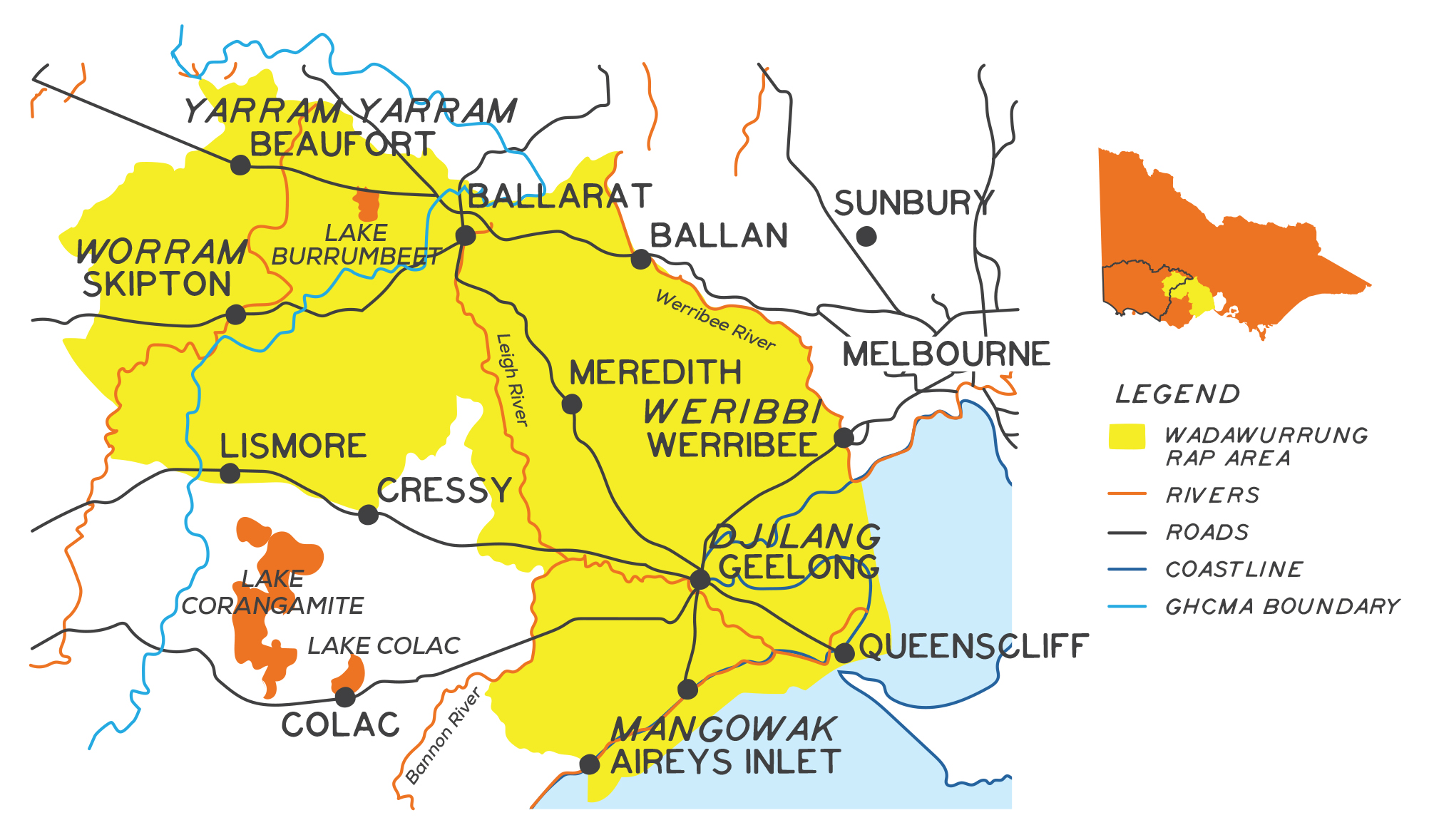Kim-barne Wadawurrung Tabayl (Welcome to Wadawurrung Country)
We acknowledge our Ancestors and our Elders past and present.
We acknowledge that our Ancestors nurtured and cared for Wadawurrung Country for tens of thousands of years.
We acknowledge the hardships, the horror and the harm that they suffered following colonisation and the devastating impacts of that, which are still evident and felt today.
The fact that Wadawurrung People and Culture have managed to survive and thrive demonstrates enormous strength, resilience and adaptability.
Wadawurrung People are determined to see their unique cultural heritage protected and respected. Wadawurrung aims to restore Traditional knowledge and authority over the management of Wadawurrung Country for the betterment of those living on, prospering from and/or simply enjoying its land, waterways and coastal areas.
Wadawurrung people are the Traditional Owners of this land. Our family have looked after and cared for this country for over a thousand generations, and are still caring for it to this very day.

Introduction
Wadawurrung Traditional Owners Aboriginal Corporation (WTOAC) is the representative body for Wadawurrung Traditional Owners. The Corporation works to support Traditional Owner aspirations and protect Aboriginal Cultural Heritage in accordance with the Victorian Aboriginal Heritage Act 2006. WTOAC was appointed in May 2009 as a Registered Aboriginal Party (RAP) under this Act.
Wadawurrung’s RAP area covers more than 10,000 km2 on the western side Melbourne and including the major regional cities of Geelong and Ballarat. This area incorporates the activities of 11 separate local councils – including many that are experiencing very high rates of growth in terms of population, infrastructure, commercial and residential development. Wadawurrung Country also incorporates the start of the Great Ocean Road, one of Australia’s most iconic and popular tourist destinations.
The Glenelg Hopkins region encompasses the north/western regions of Wadawurrung Country. Towns within this area include Beaufort, Skipton, Snake Valley and Stockyard Hill. Some of the significant places for Wadawurrung within Glenelg Hopkins region include Mt Emu creek, Lake Burrumbeet, Fiery Creek and Lake Goldsmith.
Our history
The Wadawurrung are the seven family groups who are the sole descendants of John Robinson, the apical ancestor. John was born in 1846 and was the son of respected Wadawurrung Elder, Cantobeen –Queen Mary of Ballarat.
Descendants of John Robinson researched their ancestry and in 1997 acquired enough information to be recognised as Traditional Owners. WTOAC was incorporated under the Aboriginal Councils and Associations Act 1976 to act on behalf of and represent the interests of all Wadawurrung people.
In 2009 WTOAC was accorded Registered Aboriginal Party (RAP) status and is the representative body for Wadawurrung Traditional Owners.
Our challenges
Key challenges identified by Wadawurrung include the fragmentation of Wadawurrung Country, and the fragmentation of agencies and authorities with the responsibility for looking after Country. There needs to be a more holistic approach. Many of the specific challenges and threats identified in the Wadawurrung Country Plan arise from this fragmentation, which weakens Country’s ability to resist threats, and undermines remediation efforts.
At an organisational level a key challenge is insufficient capacity to undertake all the programs and activities that caring for Wadawurrung Country and people requires. Partnerships are an important way for Wadawurrung to achieve their goals in the short and medium term. A summary of the major challenges and threats to the management of Wadawurrung Country are outlined below. More detail can be found in Paleert Tjara Dja (Let’s make Country good together 2020-2030, Wadawurrung Country Plan).
| Key challenges and threats | Description |
|---|---|
| Lack of recognition | Many land managers do not recognise Wadawurrung people as the Traditional Owners and custodians of Wadawurrung Country. We are often excluded from decision making processes regarding what happens on Country. This is disempowering and not best for Country. By recognising us as the Traditional Owners and working with us to take care of Country we will all benefit. |
| Urban development | Much of our Country has been substantially modified by urban development, particularly in those areas centred on Geelong and Ballarat. Our Country is experiencing the largest urban growth corridor in Victoria. |
| Lack of coordination between land managers | The way the land is managed now is not working well. We want it to be looked after in a coordinated and holistic way |
| Rising sea temperatures | Sea surface temperature is projected to increase in the range of 1.6 to 3.4°C by 2090 under high carbon emissions. This poses a significant threat to the marine environment through biological changes in marine species, including local abundance, community structure and enhanced coral bleaching risk. |
| Sea level rise | Sea level rises due to climate change will lead to inundation of coastal areas and loss of cultural sites. |
| Yalluk (water) extraction | This harms our plants, animals, their homes, the nurseries for species such as wetland birds, fish and shellfish. This also affects their ability to feed, breed and impacts our cultural values and stories. |
| Lack of capacity | It is our cultural obligation to look after Wadawurrung Dja but there are only a few people who have jobs taking care of Country. |
| Inappropriate visitation and vandalism | While we welcome visitors to our Country we want them to be respectful, be careful and educated about the impact they have. |
| Inappropriate location of windfarms | We encourage and value green technology that limits harm to Country however windfarms have often been constructed in the wrong place. |
| Cinnamon fungus (Phytophthora cinnamomi) | Our Wiyn (fire) trees, the grass trees and other native plants are being killed by this fungus. |
| Weeds | Many types of plants found on Country are non-indigenous species that have come from other places. Some do very well and become weeds spreading rapidly, causing harm and stopping our native plants from thriving. |
| Bushfires | Our Wadawurrung ancestors managed Dja (Country) with Wiyn (fire). Ongoing traditional burning management can reduce the destruction of hot and rapid bushfires. |
| Drought | More frequent and more severe droughts due to climate change will result in less water in waterways and wetlands and therefore less water for plants and animals. |
| Rabbits | A single pair can produce 30-40 young a year. Rabbits establish warrens where suitable soil conditions allow and quickly establish breeding populations. They cause loss of plant cover and soil erosion through eating native plants and digging burrows. |
| Foxes and cats | These are pest predators that kill our native mammals like boo (bandicoot), spotted-tailed yoorn (quoll), birds like orange-bellied parrot and reptiles. |
Our future
Wunggurrwil gupma bengadak Wadawurrung wurring-wurring baap dja (all people working together to make Wadawurrung Country and Culture strong)
The Wadawurrung family share an intrinsic connection to their Country and continue to practise culture for the benefit and health of Country and Wadawurrung people. With the continuing practice of culture, Wadawurrung people can ensure Country is recognised, respected and healthy.
Wadawurrung aims to restore traditional knowledge and authority over the management of Wadawurrung Country for the betterment of those living on, prospering from it or simply enjoying its land, waterways and coastal areas. Key initiatives will include:
- Implementing the country plan to position Wadawaurrung as a cultural authority and key partner in projects and activities on Wadawurrung Country.
- Strengthening Wadawurrung’s position in waterway and catchment management through partnerships with CMAs and other agencies.
Cultural burning
Since 2019 Wadawurrung Traditional Owners have been leading the reintroduction of cultural burning to heal Country and people through the Victorian Volcanic Plains recovery project – in partnership with Glenelg Hopkins CMA.
Frequent cool season fires were an important part of grassland ecology pre-colonisation, thinning out grass and promoting the growth of diverse herbaceous species including the endangered spiny rice flower (Pimelea spinescens). The reintroduction of cultural burning plays an important part in protecting these endangered temperate grassland ecosystems and supporting cultural strengthening.
Wadawurrung’s detailed vision and plan for the future is documented in Paleert Tjaara Dja (Let’s make Country good together 2020-2030 – Wadawurrung Country Plan). It outlines three programs to reduce threats and promote Wadawurrung values:
- Gobata Dja baap Ngubiyt (Taking care of Country and waters)
- Gobata bengadak tjaara (Us supporting us – Cultural strengthening)
- Wurrgurrwilwa Wadawurrung Corporation (Strengthening Wadawurrung Corporation)
The priority areas Wadawurrung have decided to focus on to reduce the worst threats and improve the health of Wadawurrung values, to heal Country and to strengthen Wadawurrung people are:
- Elder support services
- The establishment and development of a Caring for Country team
- Cultural burning programs
- Cultural heritage management
- A culture and language strengthening program
- A cultural centre for sharing, education and enterprise.



